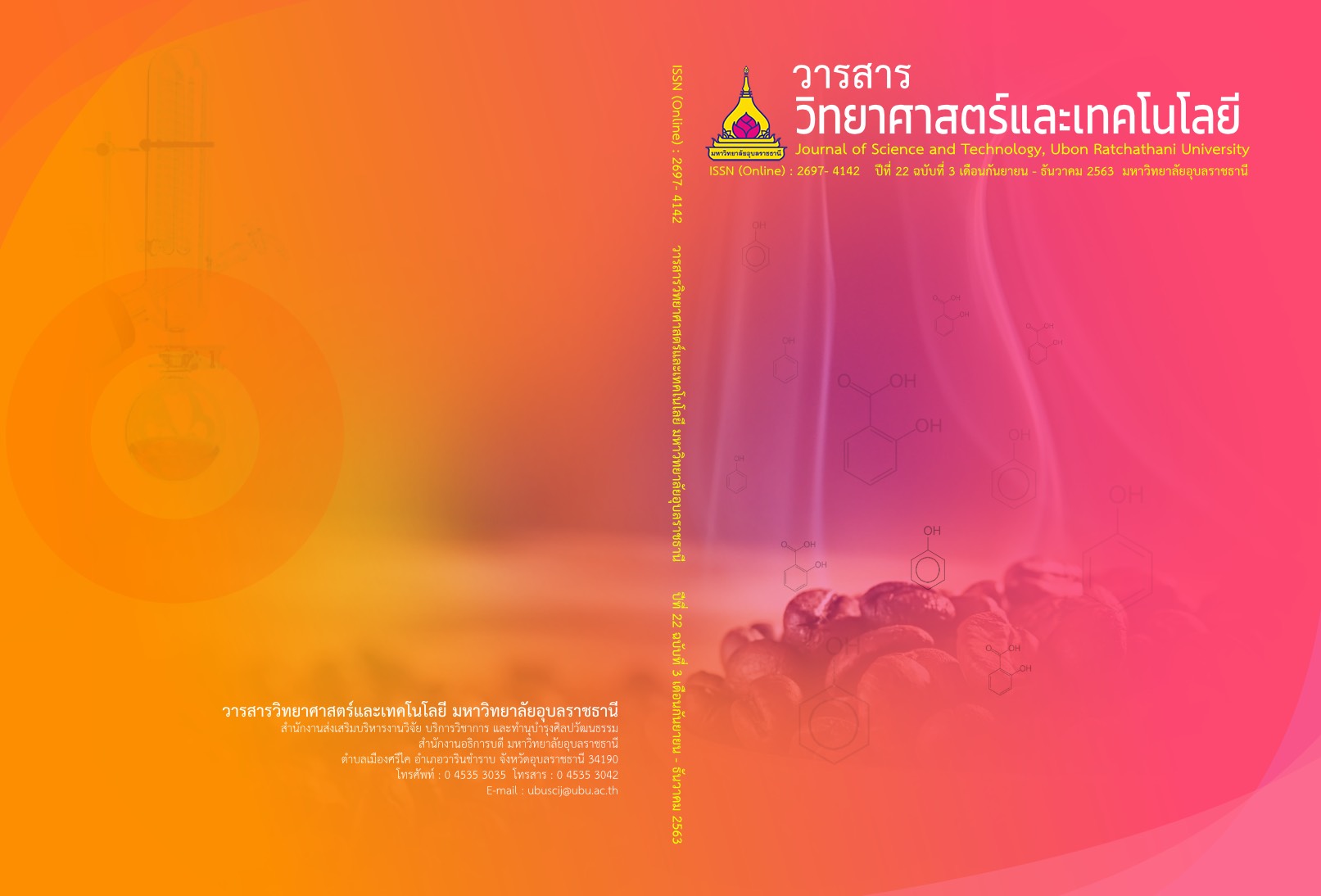ผลของการใช้เมล็ดถั่วพูป่นในสูตรอาหารเลี้ยงปลานิล
Main Article Content
บทคัดย่อ
งานวิจัยนี้ศึกษาผลการใช้เมล็ดถั่วพูป่นในสูตรอาหารเลี้ยงปลานิล โดยมีวางแผนการทดลองแบบสุ่มสมบูรณ์ ซึ่งประกอบด้วย 4 ชุดการทดลอง ๆ ละ 3 ซ้ำ ทำการทดลองเลี้ยงปลานิล (Oreochromis niloticus) น้ำหนักเริ่มต้น 2.74±0.54 - 3.18±0.31 กรัมต่อตัว ในตู้กระจกขนาด 46x137x53 เซนติเมตร ที่ความหนาแน่น 20 ตัวต่อตู้ ให้อาหารที่มีเมล็ดถั่วพูป่นในสัดส่วน 0, 10, 20 และ 30 เปอร์เซ็นต์ มีระดับโปรตีน 26 เปอร์เซ็นต์ และพลังงาน 275 กิโลแคลอรี่ต่อ 100 กรัม เป็นระยะเวลา 60 วัน เมื่อสิ้นสุดการทดลอง พบว่าการรอดตายของปลานิลทุกชุดการทดลองไม่แตกต่างกันทางสถิติ (p> 0.05) โดยมีการรอดตาย 84.10, 75.40, 86.96 และ 81.16 เปอร์เซ็นต์ ตามลำดับ แต่ปลานิลที่ได้รับเมล็ดถั่วพูป่นทุกระดับมีอัตราการเปลี่ยนอาหารเป็นเนื้อต่ำกว่าอย่างมีนัยสำคัญทางสถิติ (p< 0.05) เมื่อเทียบกับชุดควบคุม ขณะเดียวกันปลานิลที่ได้รับเมล็ดถั่วพูป่น 20 ถึง 30 เปอร์เซ็นต์ มีน้ำหนักตัวสุดท้ายสูงที่สุด อย่างไรก็ตาม ปลาทุกชุดการทดลองมีอัตราการเจริญเติบโตจำเพาะไม่แตกต่างกันทางสถิติ (p> 0.05) ผลการวิจัยในครั้งนี้สรุปว่า การผสมเมล็ดถั่วพูป่นเสริมในอาหารเลี้ยงปลานิล 30 เปอร์เซ็นต์ มีความเหมาะสมที่สุด สามารถทำให้ต้นทุนค่าอาหารลดลง 38.55 เปอร์เซ็นต์ เมื่อเทียบกับชุดควบคุม
Article Details
บทความที่ได้รับการตีพิมพ์เป็นลิขสิทธิ์ของ วารสารวิทยาศาสตร์และเทคโนโลยี มหาวิทยาลัยอุบลราชธานี
ข้อความที่ปรากฏในบทความแต่ละเรื่องในวารสารวิชาการเล่มนี้เป็นความคิดเห็นส่วนตัวของผู้เขียนแต่ละท่านไม่เกี่ยวข้องกับมหาวิทยาลัยอุบลราชธานี และคณาจารย์ท่านอื่นๆในมหาวิทยาลัยฯ แต่อย่างใด ความรับผิดชอบองค์ประกอบทั้งหมดของบทความแต่ละเรื่องเป็นของผู้เขียนแต่ละท่าน หากมีความผิดพลาดใดๆ ผู้เขียนแต่ละท่านจะรับผิดชอบบทความของตนเองแต่ผู้เดียว
References
[2] Mutia, R. and Uchida, S. 1993. Effect of heat treatment on nutrition value of winged bean (Psophocarpus tetragonolobus) as compared to soybean : I. Chemial characteristics of treats winged bean. Asian-Australasian Journal of Animal Sciences. 6 (1). 19-26.
[3] Kadam, S. S. and Salunkhe, D. K.. 1984. Winged bean in human nutrition. Food. Sci. Nutr.. 21(1):1-40.
[4] Murugiswamy, B. and Vamadevaiah, H.M. and Madaiah, M. 1983. Fatty acid composition of winged bean seed oil (Psophocarpus tetragonolobus) Fette Seifen Anstrichmittel. 85(3): 121-122.
[5] Fagbenro, O.A. 1999. Formulation and evaluation of diets for the African catfish, Clarias gariepinus (Burchell), made by partial replacement of fish meal with winged bean (Psophocarpus tetragonolobus L. DC) seed meal". Aquaculture Research. 30 (4): 249-257.
[6] Jaffe, W. G. and Kote, R. 1976. Nutrition characteristic of the winged bean in rats. Nutr. Rep. Int. 14: 445-49.
[7] De lumen, B. O., Gerpacio, A.L. and Vohra, P. 1982. Effects of winged bean (Psophocarpus tetragonolobus) meal on broiler performance. Poultry Science. 61:1099-1106.
[8] Mutia, R and Uchida, S. 1999. Effects of Feeding Winged Bean Oil on Cholesterol and Lipid Contents in Egg and Liver, and Fatty Acid Composition of Egg in Japanese Quail. Asian-Australasian Journal of Animal Sciences. 12(3): 376-380.
[9] Fagbenro, A. 1999. Comparative evaluation of heat-processed winged bean Psophocarpus tetragonolobus meals as partial replacement for fish meal in diets for the African catfish Clarias gariepinus. Aquaculture. 170, 297-305.
[10] Lebel, P. and et al. 2013. River-based cage
aquaculture of Tilapia in northern Thailand: Sustainability of rearing andbusiness practices. Natural Resources. 4 (5): 410-421.
[11] A.O.A.C. 2000. Official methods of Analysis.
Association of Official Analytical Chemists; Washington, DC.
[12] Hashim, R. 1995. The effect of the partial replacement of fish meal with winged bean seed meal and whole winged bean (Psophocarpus tetragonolobus) on growth of red tilapia fingerlings. Malaysian Journal of Animal Science (Malaysia). 1 (1): 29-32.
[13] Bake, G.G., Adejumo. T. M. and Sadiku, S.O.E. 2013. Growth performance and nutrient utilization of nile tilapia (Oreochromis niloticus) fed toasted flamboyant seed meal (Delonix regia). Continental J. Agricultural Science. 7 (1): 1 - 10
[14] Deyab, D. M.S. and et al. 2009. Nutrition evaluation of sesame seed meal, Sesamum indicum (L.) as alternative protein source in diets of juvenile mono-sex Nile tilapia (Oreochromis niloticus). Egypt. J. Aquat. Biol. & Fish. 13 (1) 93-106.

